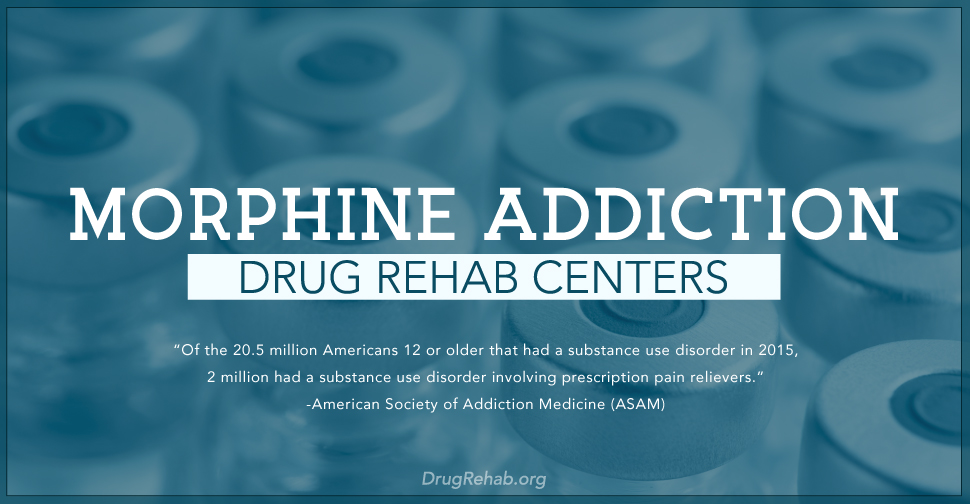
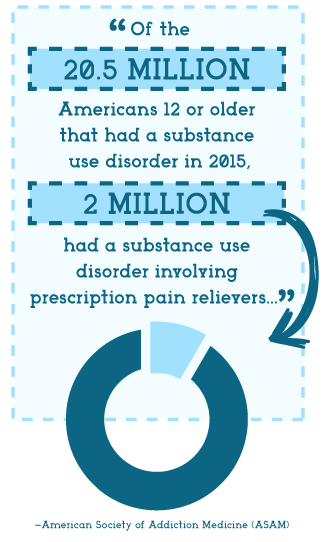 If you think about drug addiction, you may not immediately think about prescription drugs, like morphine. We tend to associate drug addiction with illicit drugs, or those drugs used for illegal purposes. However, prescription drug abuse is on the rise in the United States. In fact, as the American Society of Addiction Medicine (ASAM) explains, “of the 20.5 million Americans 12 or older that had a substance use disorder in 2015, 2 million had a substance use disorder involving prescription pain relievers…”
If you think about drug addiction, you may not immediately think about prescription drugs, like morphine. We tend to associate drug addiction with illicit drugs, or those drugs used for illegal purposes. However, prescription drug abuse is on the rise in the United States. In fact, as the American Society of Addiction Medicine (ASAM) explains, “of the 20.5 million Americans 12 or older that had a substance use disorder in 2015, 2 million had a substance use disorder involving prescription pain relievers…”
Morphine is one of the many pain relieving drugs which presents risk of addiction. Prescription drug abuse is the addiction that some may not even see coming; people may think they are not at risk for addiction because morphine, and other opioid pain relievers, are doctor-prescribed. But many opioids present risk of abuse or developing addiction, even if taken for only a short time. Because of this, it is best to always take prescription medications as directed, and to see a doctor if you need any changes to dosage or frequency in administration.
For those affected by prescription drug abuse, or who suspect abuse in people close to them, it may be helpful to understand prescription drugs like morphine—what it is, risk of developing an addiction to it, possible side effects, overdose symptoms, treatments, and how to find morphine addiction drug rehab centers.
What Is Morphine?
Morphine is an opioid analgesic (a narcotic), typically prescribed to treat moderate to severe pain. Narcotic prescriptions are not prescribed for everyday pain that can be remedied with simple pain relievers. Morphine is used to treat pain that does not subside with over-the-counter medications or medications of a lesser strength. The U.S. National Library of Medicine explains that morphine works “by changing the way the brain and nervous system respond to pain.”
Because morphine is a narcotic, it comes with high potential for abuse and risk for developing an addiction, as many opioids do. This is because of the way narcotics change the brain and nervous system. Opioids work by attaching to opioid receptors in the brain, disrupting the normal communication system, and producing a surplus of happy chemicals (this causes the rush feeling for those who abuse it, and the euphoric feeling for those using it). People using this medication may not even realize their brain is changing to make them want that feeling again and again. For this reason, doctors typically prescribe morphine for only a short period of time to avoid risk of developing addiction. However, when taken as prescribed, and monitored closely, morphine can help a person gain some much-needed relief.
What Are The Risks Of Morphine Addiction?
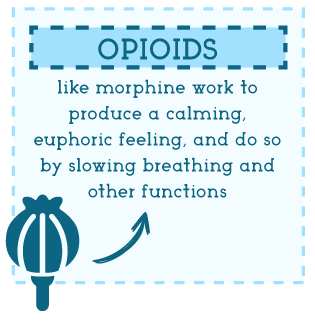 While abuse of any drugs can be harmful to a person, abuse of morphine and other prescription drugs can lead to addiction, tolerance, dependence, and overdose, which can be fatal. Tolerance is a property of opioids which makes them so potentially dangerous. With prolonged abuse, a person no longer responds to the effects of opioids like morphine, requiring more frequent and higher doses to achieve the same effects. But opioids like morphine work to produce a calming, euphoric feeling, and do so by slowing breathing and other functions. They are also typically designed to be slow to release, and are usually prescribed in extended-release tablets or capsules. When people change the way these drugs are administered (such as crushing and snorting them instead of taking them orally) in order to force a faster release of the drug, they force the drug to release chemical properties in a short period of time which should be meted out over several hours. Thus, taking frequent or increased doses or changing the administration of opioids can put a person at risk of overdose; too much of a drug which slows the breathing or heart rate can have dire consequences.
While abuse of any drugs can be harmful to a person, abuse of morphine and other prescription drugs can lead to addiction, tolerance, dependence, and overdose, which can be fatal. Tolerance is a property of opioids which makes them so potentially dangerous. With prolonged abuse, a person no longer responds to the effects of opioids like morphine, requiring more frequent and higher doses to achieve the same effects. But opioids like morphine work to produce a calming, euphoric feeling, and do so by slowing breathing and other functions. They are also typically designed to be slow to release, and are usually prescribed in extended-release tablets or capsules. When people change the way these drugs are administered (such as crushing and snorting them instead of taking them orally) in order to force a faster release of the drug, they force the drug to release chemical properties in a short period of time which should be meted out over several hours. Thus, taking frequent or increased doses or changing the administration of opioids can put a person at risk of overdose; too much of a drug which slows the breathing or heart rate can have dire consequences.
Further, prescription opioid abuse puts a person at risk of developing further drug abuse. As the Substance Abuse and Mental Health Services Administration (SAMHSA) states, “as people use opioids repeatedly, their tolerance increases and they may not be able to maintain the source for the drugs. This can cause them to turn to the black market for these drugs and even switch from prescription drugs to cheaper and more risky substitutes like heroin.” In other words, morphine addiction could be the gateway for further addiction to illicit drugs, a substance use disorder that can be detrimental to a person’s health, personal life, and spirit.
What Are The Side Effects Of Morphine?
As with any medication, morphine comes with a host of side effects, which may increase with abuse. Some side effects may include the following:
- Changes in mood
- Changes in pupils (condition known as pinpoint pupils)
- Drowsiness
- Dry mouth
- Feeling of nervousness
- Headaches
- Troubles or pain with urination
More severe side effects can be dangerous. People abusing morphine who experience the following should seek medical care:
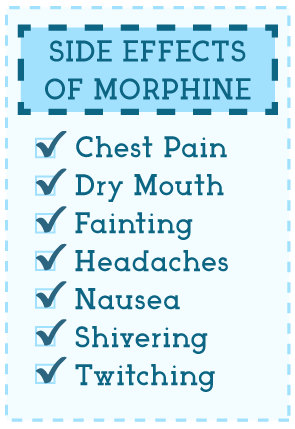 Agitation
Agitation- Appetite loss
- Changes to sexual desire
- Chest pain
- Confusion
- Diarrhea
- Dizziness
- Extreme stiffness of the muscles
- Fainting
- Fever
- Hallucinations
- Increased sweating
- Loss of coordination
- Nausea
- Skin discoloration (blue colored)
- Rapid heartbeat
- Seizures
- Shivering
- Troubles with erections
- Troubles with menstruation
- Twitching
- Vomiting
- Weakness
What Are The Overdose Symptoms?
Unfortunately, for a person affected by morphine abuse, overdose is a possible risk. Overdose occurs due to an excess of the drug in a person’s system, either at one time or over frequent, repeated doses. Depending on the person’s physical state, you may want to contact emergency services and stay with the person until medical care can be secured. Some things to watch for are if the person is experiencing trouble breathing, such as slow, shallow, or irregular breathing patterns, or a slowed heartbeat. Some people undergoing overdose may also faint (lose consciousness), and may then have limp muscles or feel extremely weak. If the person is conscious, you may notice the pinpoint pupils, which can often be a telltale sign. People who may be on the verge of overdose may also have cold, clammy skin, feel like they are going to faint, feel incredibly nauseous, or may have blurred vision. If you suspect someone you know may be experiencing an overdose, it may be vital to seek medical care right away.
What Treatments Are Available For Morphine Addiction?
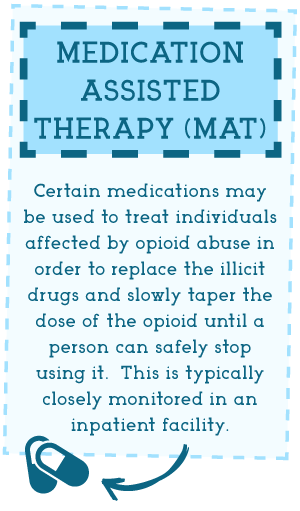 Most people entering treatment for prescription opioid drugs begin with a detox period. During this period, the person abstains from drug abuse completely, ridding the body of harsh chemicals it may be harboring from prolonged abuse. For some, medication may provide relief by helping to wean a person from substance abuse. Certain medications may be used to treat individuals affected by opioid abuse in order to replace the illicit drugs and slowly taper the dose of the opioid until a person can safely stop using it. Medication Assisted Therapy (MAT) is typically closely monitored in an inpatient facility.
Most people entering treatment for prescription opioid drugs begin with a detox period. During this period, the person abstains from drug abuse completely, ridding the body of harsh chemicals it may be harboring from prolonged abuse. For some, medication may provide relief by helping to wean a person from substance abuse. Certain medications may be used to treat individuals affected by opioid abuse in order to replace the illicit drugs and slowly taper the dose of the opioid until a person can safely stop using it. Medication Assisted Therapy (MAT) is typically closely monitored in an inpatient facility.
After the detoxification period, a person can begin treatment. Inpatient drug rehab centers may provide the environment addicted individuals need to begin recovery. At these rehab centers, participants stay in the facility for the duration of their treatment, and are supported by professional staff all hours of the day. Participants engage in group therapy, may be part of a 12-step program which provides principles for living a substance-free life, attend individual therapy sessions, and receive counseling.
Aftercare is important, too. Once a person has completed a stay at a drug rehab center, he may connect with a support group, such as Narcotics Anonymous (NA), to continue recovery goals. With this sort of confidential group, recovering individuals connect with people who have shared similar experiences, can share thoughts, give support, or lend a listening ear. These group meetings allow a person to have continued support in recovery while maintaining a regular lifestyle.
How To Find Morphine Addiction Drug Rehab Centers
Are you currently watching someone you know or love struggle with morphine addiction? Perhaps you are wondering if there is a way that person can get the help he or she needs, but don’t know where to look for help. With our team of experts, we can aid you in your search for the proper treatment for you or your loved one.
Contact us today at DrugRehab.org to learn how to find drug rehab centers best suited for your treatment needs.
For More Information Be Sure To Check Out These Additional Resources From DrugRehab.org:
- Opiate Epidemic Is Changing Pain Management
- The 45 Warning Signs Of Prescription Drug Abuse
- How To Stop Prescription Drug Abuse
- The Most Commonly Abused Opiates
- Heroin and Opioid Addiction Statistics
- Is Tramadol An Opioid Analgesic?
Sources
Centers For Disease Control and Prevention—Prescription Opioids: Risk Factors
DrugFreeWorld.org—Opioids And Morphine Derivative Effects
National Institute On Drug Abuse—Prescription Opioid And Heroin Abuse


